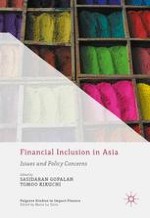2016 | OriginalPaper | Chapter
3. Does Financial Inclusion Reduce Poverty and Income Inequality in Developing Asia?
Authors : Cyn-Young Park, Rogelio V. Mercado Jr.
Published in: Financial Inclusion in Asia
Publisher: Palgrave Macmillan UK
Activate our intelligent search to find suitable subject content or patents.
Select sections of text to find matching patents with Artificial Intelligence. powered by
Select sections of text to find additional relevant content using AI-assisted search. powered by
